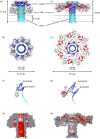Molecular mechanism of pore formation by aerolysin-like proteins
- PMID: 28630149
- PMCID: PMC5483512
- DOI: 10.1098/rstb.2016.0209
Molecular mechanism of pore formation by aerolysin-like proteins
Abstract
Aerolysin-like pore-forming proteins are an important family of proteins able to efficiently damage membranes of target cells by forming transmembrane pores. They are characterized by a unique domain organization and mechanism of action that involves extensive conformational rearrangements. Although structures of soluble forms of many different members of this family are well understood, the structures of pores and their mechanism of assembly have been described only recently. The pores are characterized by well-defined β-barrels, which are devoid of any vestibular regions commonly found in other protein pores. Many members of this family are bacterial toxins; therefore, structural details of their transmembrane pores, as well as the mechanism of pore formation, are an important base for future drug design. Stability of pores and other properties, such as specificity for some cell surface molecules, make this family of proteins a useful set of molecular tools for molecular recognition and sensing in cell biology.This article is part of the themed issue 'Membrane pores: from structure and assembly, to medicine and technology'.
Keywords: aerolysin; lysenin; membranes; monalysin; pore formation; pore-forming protein.
© 2017 The Author(s).
Conflict of interest statement
We have no competing interests.
Figures



References
-
- Anderluh G, Gilbert RJ (eds) 2014. MACPF/CDC proteins—agents of defence, attack and invasion. The Netherlands: Springer.
Publication types
MeSH terms
Substances
LinkOut - more resources
Full Text Sources
Other Literature Sources
